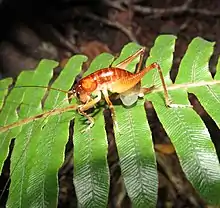Hemiandrus electra
Hemiandrus electra, the Kahurangi ground wētā, is a species of ground wētā endemic to New Zealand.[1] Being a ground wētā, they are often found in burrows in the ground during the daytime (as they are also nocturnal). The species is occurs on the South Island and is classified as "Naturally Uncommon".[2] This species of wētā is unusual for an insect in that the female looks after her eggs and nymphs; this is known as maternal care.
| Hemiandrus electra | |
|---|---|
 | |
| Scientific classification | |
| Domain: | Eukaryota |
| Kingdom: | Animalia |
| Phylum: | Arthropoda |
| Class: | Insecta |
| Order: | Orthoptera |
| Suborder: | Ensifera |
| Family: | Anostostomatidae |
| Genus: | Hemiandrus |
| Species: | H. electra |
| Binomial name | |
| Hemiandrus electra Taylor Smith, Morgan-Richards, Trewick 2013 | |

Taxonomy
Hemiandrus electra was first described in 2013, but had been referred to in previous publications by an informal (tag) name (Hemiandrus 'okiwi').[1][3] The species name comes from the Greek name Elektra, one of the Pleiades sisters (in Greek mythology the seven daughters of Pleione and Atlas), meaning amber or shinning. This name is given to this species due to the bight orange colour of the insects, and as sister to H. maia, a reference to their morphological similarity.[1]
Habitat/distribution
Hemiandrus electra are endemic to the South Island of New Zealand. Because they are a ground wētā, they are often found in burrows in the ground during the day, as they are a nocturnal species.[4] During the night however, they are quite active on the ground, but are also found in vegetation.
Conservation
The New Zealand Department of Conservation classified this species as naturally uncommon[2]
Diet
Hemiandrus electra is probably omnivorous, but has only been observed eating invertebrates such as cicada [1]
Morphology
Kahurangi ground wētā females have a medium-length ovipositor.[1] Male and females have fore tibiae with a single superior prolateral spine (excluding apical spine); mid tibiae with two superior prolateral spines and three superior retrolateral spines (excluding apical spines). Morphological they are very similar to the Otago ground wētā H. maia, but can be distinguished by number of tergal stridulatory pegs and male terminalia.[1]
Behavior
Hemiandrus electra come out of their burrows at night.[1] During mating males provide the female with a nuptial food gift. The females share burrows with their eggs and care for nymphs.[1]
References
- Smith, BL Taylor; Morgan-Richards, M.; Trewick, SA (2013). "New Zealand ground wētā (Anostostomatidae: Hemiandrus): descriptions of two species with notes on their biology". New Zealand Journal of Zoology. 40 (4): 314–329. doi:10.1080/03014223.2013.804422. ISSN 0301-4223.
- Steve Trewick; Peter Johns; Rod Hitchmough; Jeremy Rolfe; Ian Stringer (2014). The conservation status of New Zealand Orthoptera, 2014 (PDF).
- Johns, Peter (2001). "Distribution and conservation status of ground weta, Hemiandrus species (Orthoptera: Anostostomatidae)" (PDF). Science for Conservation. 180 – via New Zealand Department of Conservation, Wellington, New Zealand.
- Gwynne, D. T. (2014). "A secondary copulatory structure in a female insect: a clasp for a nuptial meal?". Naturwissenschaften. 89 (3): 125–127. doi:10.1007/s00114-002-0298-y. PMID 12046632. S2CID 28093747.